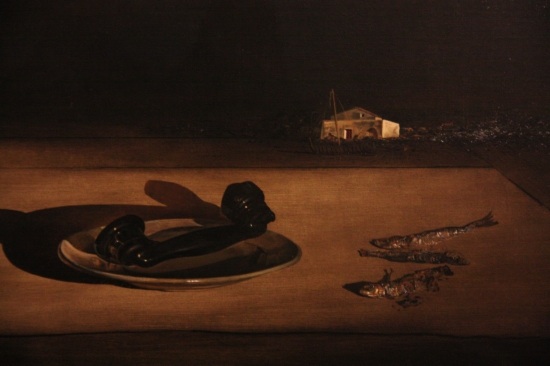Dalí war painting purchased and exhibited by Figueres museum
The Fundació Gala-Salvador Dalí, which runs the surrealist genius’ museum in Figueres (near Catalonia’s Costa Brava and the French border), has purchased ‘Violetes imperials’ (‘Imperial violets’) from a private collector. The piece from 1938 is a dark creation, painted during Spain’s Civil War and just before the start of the Second World War. It will be on display at the museum from Tuesday onwards. The painting, the price of which has not been disclosed, belongs to the Catalan artist’s surrealist period, but does not employ the colours regularly used by Dalí. Nonetheless, ‘Violetes imperials’ does depict some of the symbols used by one of the world’s most important artists of the 20th century.

Figueres (ACN).- The Fundació Gala-Salvador Dalí, which runs the surrealist genius’ museum in Figueres (near Catalonia’s Costa Brava and the French border), purchased ‘Violetes imperials’ (‘Imperial violets’) from a private collector who wants to remain anonymous. This large-format canvas from 1938 is a dark creation, painted during Spain’s Civil War and just before the start of Second World War, during Hitler’s first military actions in Europe. It shows a black telephone without wire and served on a plate, next to three deep-fried sardines. In the background, there is a fisherman’s hut and the outline of a boat surrounded by emptiness and showing a coast with blurry mountains and some shadows. “It was a premonition of the Second World War”, stated the Director of the Teatre-Museu Salvador Dalí in Figueres, Antoni Pitxot, during the painting’s presentation on Monday. The painting, the price of which has not been disclosed, belongs to the Catalan artist’s surrealist period, but it does not employ the colours regularly used by Dalí. Nonetheless, ‘Violetes imperials’ does depict some of the symbols used by one of the world’s most important artists of the 20th century, such as telephones, leftover food and deserted landscapes. From Tuesday until the summer, it will be on display in a special part of the Figueres museum, which hosts the world’s largest collection of works by Dalí.
Coinciding with the end of the 40th anniversary celebrations of the Salvador Dalí’s theatre-museum in Figueres (the artist’s hometown), the foundation managing the Catalan painter’s legacy has presented its newest acquisition: an oil on canvas painting measuring 100 x 142.5cm. The Gala-Salvador Dalí foundation has purchased some 300 works of the artist since its creation, mostly to feed its 3 art centres devoted to Dalí: the museum built in an old theatre in Figueres, his castle in Púbol (near Girona) and his Port-lligat residence in Cadaqués, in the Creus Cape at the Costa Brava.
The painting’s main element is a telephone handset which appears to be missing its wires and the rest of the phone. The handset is lying on a golden plate. In 1938, the telephone was a great technological achievement, but it was nevertheless useless in building a dialogue between Western democracies and Nazi Germany. It symbolises a lack of agreement, whereby war cannot be avoided. Next to it, also in the composition’s forefront there are 3 deep-fried sardines: a humble and tasty food typically eaten by Catalan fishermen. The sardines’ symbolism is more open to interpretation, but it could symbolise Dalí’s everyday life in the Costa Brava and therefore everybody’s everyday life. The fisherman’s hut in the background backs this theory.
However, the painting does not show a recognisable coast line, such as the Creus Cape, which appears in many of his paintings. This may be to underline the universal ambition of the work but also to highlight that the Catalan genius is far away from his homeland due to the Spanish Civil War. Indeed, the piece was painted in several houses in Monaco, France and Italy in 1938, in the middle of Spain’s civil war and the negotiation between British Prime Minister Neville Chamberlain and Adolf Hitler. There is also depicted the projected shadow of an adult giving his hand to a child. Most of the painting is also under the shadow of a mysterious shape, which is similar to a piano cover, another one of Dalí’s signature symbols. The painting “was a premonition of the Second World War”, stated the Director of the Teatre-Museu Salvador Dalí in Figueres during the presentation.
The Catalan artist presented the painting in 1938, in his Paris home. Later, in 1941, Dalí art collector and philanthropist Edward James bought it and donated the work to New York’s Museum of Modern Art (MoMA). ‘Violetes imperials’ was on display there until it was sold at auction in the 1970s, when it was purchased by a private collector. This person has now sold the painting to the Fundació Gala-Salvador Dalí. The transaction’s amount has not been disclosed, since the foundation tends not to disclose the price of its acquisitions and the anonymous collector also did not want it made public.
At the time the work was painted, Dalí and his muse, Gala, were combining stays in their Port-lligat house with visits to friends throughout Europe and stays in France. On one of these visits, at Coco Chanel’s house on the Costa Brava, Dalí saw the movie ‘Violettes Impériales’ from 1923. The artist decided to name the work after the film.